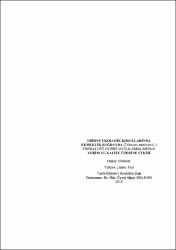| dc.contributor.author | Irmak, Hakan | |
| dc.date.accessioned | 2020-01-30T11:19:06Z | |
| dc.date.available | 2020-01-30T11:19:06Z | |
| dc.date.issued | 2019 | |
| dc.identifier.uri | https://hdl.handle.net/20.500.11776/3515 | |
| dc.description.abstract | Bu araştırma, farklı üst gübre uygulamalarının Trakya Bölgesi’nde yaygın olarak yetiştirilen dört ekmeklik buğdayın çeşidinin (Selimiye, Esperia, Gelibolu ve Rumeli) Edirne ekolojik koşullarında tane verimi ve kalite özellikleri üzerine etkisini belirlemek amacıyla yürütülmüştür. Deneme, 2016-2017 ve 2017-2018 buğday yetiştirme dönemlerinde, tesadüf bloklarında bölünmüş parseller deneme desenine göre üç tekrarlamalı olarak üretici tarlasında kurulmuştur. Denemede, çeşitler ana parsellere, beş farklı üst gübre uygulaması alt parsellere yerleştirilmiştir. Çalışmada, tüm parsellere ekim ile birlikte 4 kg/da saf azot (N) ve 4 kg/da saf fosfor olacak şekilde 20.20.0 taban gübresi uygulanmıştır. Daha sonra beş farklı azotlu üst gübre uygulaması (1. uygulama: kardeşlenme başlangıcında üre formunda 8 kg/da saf N, sapa kalkma başlangıcında kalsiyum amonyum nitrat (CAN) formunda 4 kg/da saf N; 2. uygulama: kardeşlenme başlangıcında üre formunda 8 kg/da saf N, sapa kalkma başlangıcında üre formunda 4 kg/da saf N; 3. uygulama: kardeşlenme başlangıcında üre formunda 4 kg/da saf N, kardeşlenme sonunda üre formunda 4 kg/da saf N ve sapa kalkma başlangıcında CAN formunda 4 kg/da saf N; 4. uygulama: kardeşlenme başlangıcında üre formunda 8 kg/da saf N, sapa kalkma başlangıcında CAN formunda 2 kg/da saf N ve sapa kalkma sonunda CAN formunda 2 kg/da saf N; 5. uygulama: kardeşlenme başlangıcı üre formunda 4 kg/da saf N, kardeşlenme sonunda üre formunda 4 kg/da saf N, sapa kalkma başlangıcında CAN formunda 2 kg/da saf N ve sapa kalkma sonunda CAN formunda 2 kg/da saf N) yapılmıştır. Böylece, tüm parsellere toplamda 16 kg saf N uygulanmıştır. Araştırmada, Edirne ekolojik koşulları için tane verimi yönünden Gelibolu çeşidi, kalite yönünden Rumeli ve Esperia çeşitleri, hem tane verimi hem de kalite yönünden ise Esperia çeşidinin öne çıkmıştır. Sonuç olarak, hem tane verimi hem de kalite için ekonomik olması da dikkate alınarak, Nisan ve Mayıs ayı yağışlarının yeterli olduğu yıllarda 2. uygulama, Nisan ve Mayıs ayı yağışlarının yetersiz olduğu yıllarda ise 3. uygulama önerilebilir. | en_US |
| dc.description.abstract | This study was carried out to determine the effect of different topdressing applications on grain yield and quality traits of four bread wheat cultivars (Selimiye, Esperia, Gelibolu and Rumeli) commonly grown in Thrace Region under Edirne ecological conditions. The experiment was conducted in the farmer fields in a randomized split-plot design with 3 replicates during the 2016-2017 and 2017-2018 wheat growing seasons. In the experiment, cultivars were alloted as main plots and five different topdressing applications were alloted as subplots. In the study, 4 kg/da pure nitrogen (N) and 4 kg/da pure phosphorus were applied to all plots as 20.20.0 base fertilizer at the sowing. Then, the five different nitrogen topdressing applications (1st application: 8 kg/da pure N in the form of urea at the beginning of tillering, 4 kg/da pure N in the form of calcium ammonium nitrate (CAN) at the beginning of stem elongation; 2nd application: 8 kg/da pure N in the form of urea at the beginning of tillering, 4 kg/da pure N in the form of urea at the beginning of stem elongation; 3rd application: 4 kg/da pure N in the form of urea at the beginning of tillering, 4 kg/da pure N in the form of urea at the end of tillering, 4 kg/da pure N in the form of CAN at the beginning of stem elongation; 4th application: 8 kg/da pure N in the form of urea at the beginning of tillering, 2 kg/da pure N in the form of CAN at the beginning of stem elongation, 2 kg/da pure N in the form of CAN at the end of stem elongation, 5th application: 4 kg/da pure N in the form of urea at the beginning of tillering, 4 kg/da pure N in the form of urea at the end of tillering, 2 kg/da pure N in the form of CAN at the beginning of stem elongation, 2 kg/da pure N in the form of CAN at the end of stem elongation) were done. In this way, 16 kg/da pure N was applied to all plots. In the research, Gelibolu cultivar for grain yield, Rumeli and Esperia cultivars for grain quality, Esperia cultivar for both grain yield and quality were prominent for Edirne ecological conditions. As a result, considering the economic efficiency for grain yield and quality, 2nd application can be proposed in the years when April and May rainfalls are sufficient, and 3rd application can be proposed in the years when April and May rainfalls are unsufficient. | en_US |
| dc.language.iso | tur | en_US |
| dc.publisher | Namık Kemal Üniversitesi | en_US |
| dc.rights | info:eu-repo/semantics/openAccess | en_US |
| dc.subject | Ekmeklik buğday | en_US |
| dc.subject | azotlu üst gübreleme | en_US |
| dc.subject | tane verimi | en_US |
| dc.subject | kalite özellikleri | en_US |
| dc.subject | Bread wheat | en_US |
| dc.subject | nitrogen topdressing | en_US |
| dc.subject | grain yield | en_US |
| dc.subject | quality traits | en_US |
| dc.title | Edirne ekolojik koşullarında ekmeklik buğdayda (triticum aestivum l. ) farklı üst gübre uygulamalarının verim ve kalite üzerine etkisi | en_US |
| dc.title.alternative | EFFECT OF DIFFERENT TOPDRESSING APPLICATIONS ON YIELD AND QUALITY IN BREAD WHEAT (Triticum aestivum L.) UNDER EDIRNE ECOLOGICAL CONDITIONS | en_US |
| dc.type | masterThesis | en_US |
| dc.department | Enstitüler, Fen Bilimleri Enstitüsü, Tarla Bitkileri Ana Bilim Dalı | en_US |
| dc.relation.publicationcategory | Tez | en_US |



















